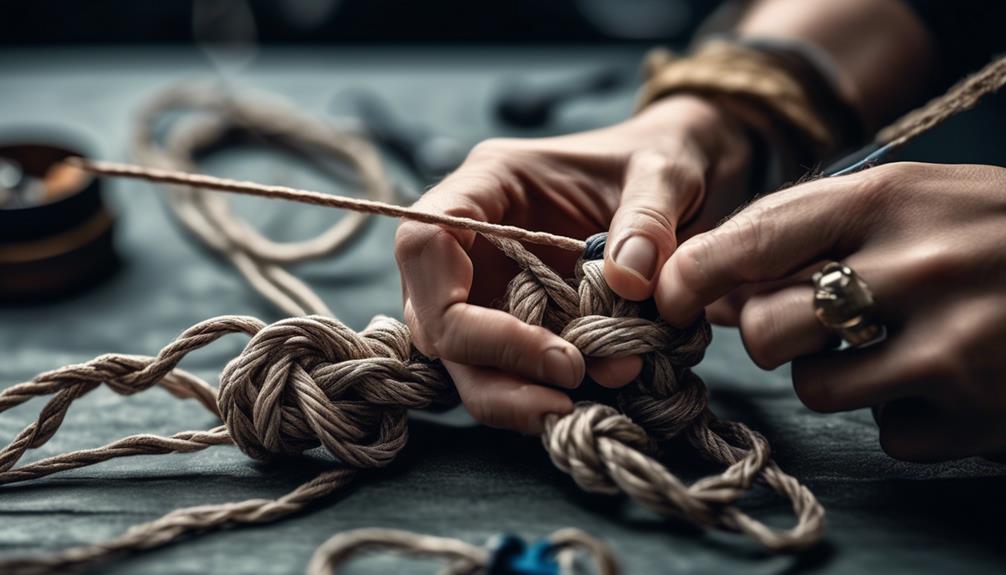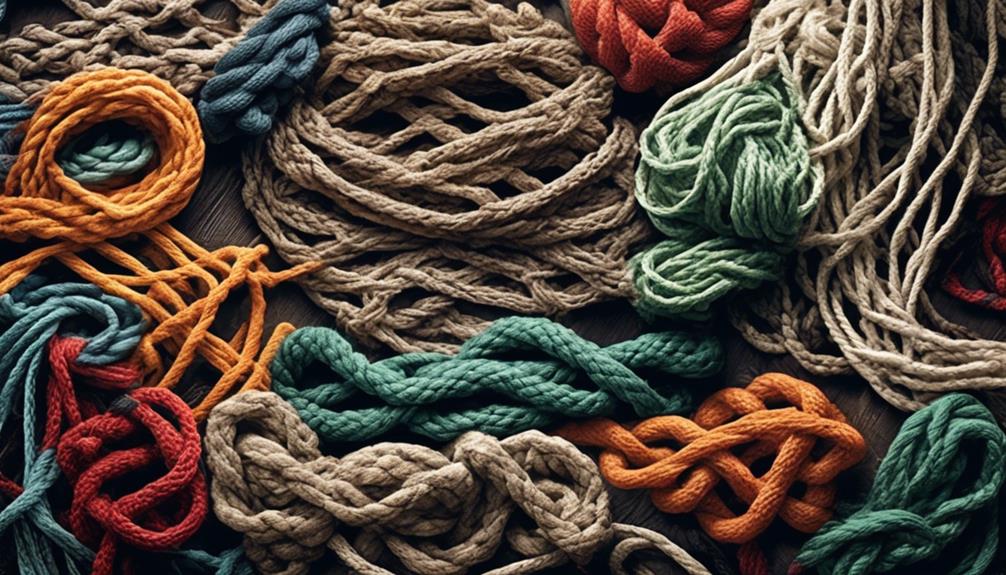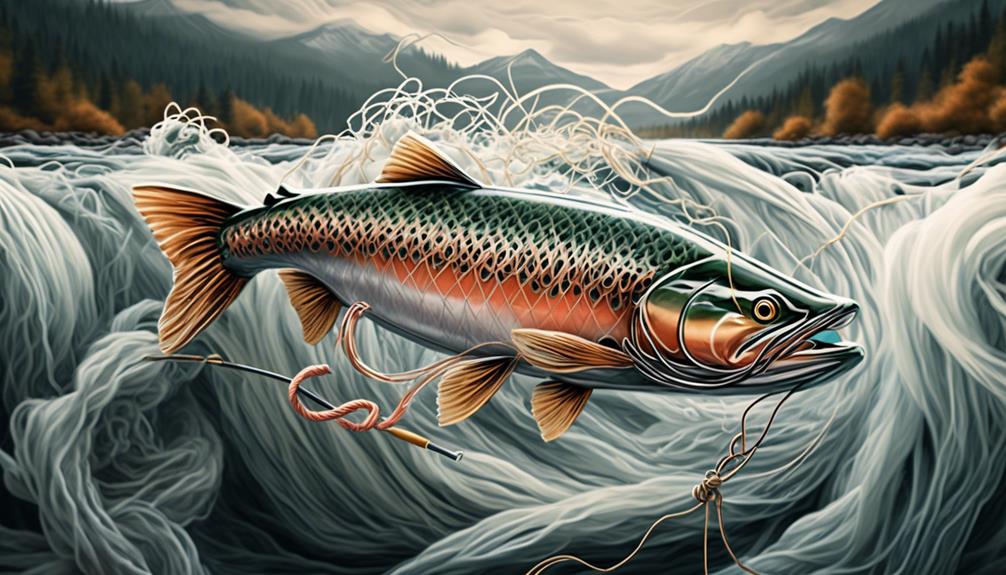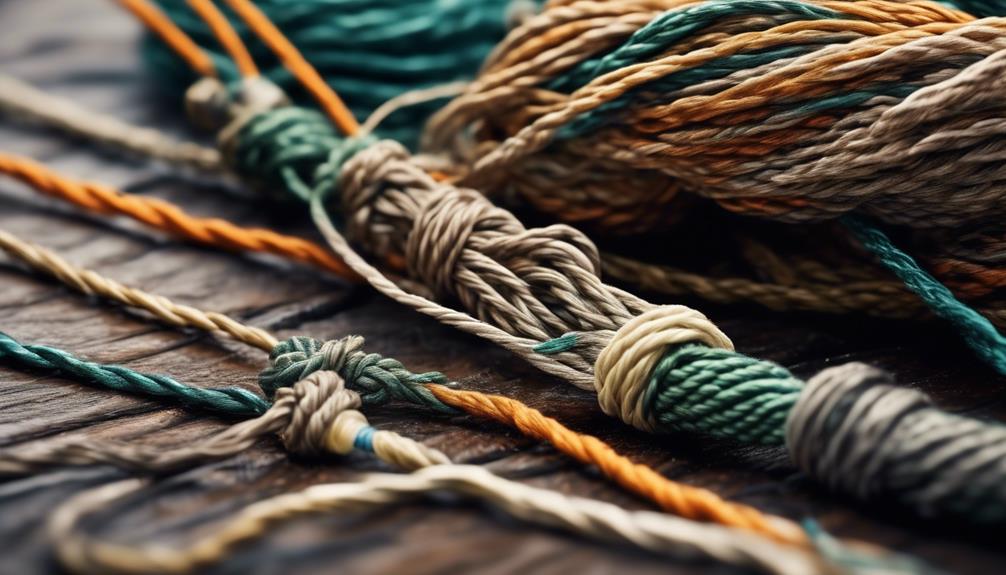You may have found that tying fishing knots can be a bit challenging at times, but fear not, as there are some handy tips that can make the process much smoother.
Whether you're a seasoned angler or just starting out, mastering fishing knots is crucial for a successful and enjoyable fishing experience. Understanding the nuances of different knots and how to tie them effectively can significantly improve your chances of landing that prized catch.
So, if you're eager to enhance your knot tying skills and take your fishing game to the next level, stick around for some valuable insights that will elevate your knot tying prowess.
The Importance of Proper Knot Tying
Mastering proper knot tying is crucial for ensuring the strength and reliability of your fishing line. When it comes to fishing, the last thing you want is for a poorly tied knot to cost you the catch of the day. Proper technique is essential in securing your hook, lure, or swivel to the line. One key aspect of proper knot tying is ensuring that the tag end, the short leftover piece of line, is properly trimmed to avoid any interference with the knot's strength.
Knot strength testing is also an important part of mastering fishing knots. After tying a knot, it's essential to test its strength before casting your line. You can do this by pulling the line at different angles to ensure that the knot holds up under pressure. This step is crucial because it allows you to identify any weak spots in the knot and make necessary adjustments.
Understanding Different Types of Fishing Knots
To become proficient in fishing, it's essential to understand the various types of fishing knots used to secure lines and tackle. When it comes to choosing the right knot for the job, considering knot strength and the type of line you're using is crucial.
Different types of knots are designed to work with specific types of fishing lines, such as monofilament, braided, or fluorocarbon lines. Each type of line has its own unique characteristics, and using the appropriate knot for the specific line can significantly impact the overall strength and reliability of the connection.
Knot strength is a critical factor to consider when selecting a fishing knot. Some knots are known for their exceptional strength, ensuring that the line remains secure when battling powerful fish. For example, the Palomar knot is celebrated for its strength and is often used with braided lines. On the other hand, the improved clinch knot is popular for its reliability with monofilament lines. Understanding the knot strength of different fishing knots allows you to make informed decisions based on the type of fish you're targeting and the conditions in which you're fishing.
When it comes to the types of line, it's important to match the knot with the specific characteristics of the line. For instance, certain knots may perform better with braided lines due to their composition, while others may be more suitable for fluorocarbon lines. Taking into account the types of line you're working with will help you select the most appropriate fishing knot for the task at hand.
Essential Tools for Tying Fishing Knots
You can enhance your knot-tying efficiency by utilizing specialized tools such as knot-tying pliers and line clippers. When it comes to tools selection, it's important to choose ones that are specifically designed for tying fishing knots. Knot-tying pliers are an essential tool as they provide a stable platform for tying knots, making the process much easier and quicker. These pliers also have a built-in line cutter, which is handy for trimming excess line after tying the knot. Line clippers are another indispensable tool for anglers, offering a precise and clean cut, which is crucial for securing knots effectively.
In addition to specialized tools, knot lubrication is an essential aspect of tying fishing knots. Using a suitable lubricant can significantly reduce friction and heat generated during the knot-tying process, leading to stronger and more secure knots. Silicone-based lubricants are popular among anglers as they're effective in reducing friction, making it easier to cinch down knots tightly. A small drop of lubricant applied to the knot before tightening can make a significant difference in the knot's overall strength.
Tips for Improving Knot Tying Skills
Improving your knot-tying skills can be achieved through consistent practice and attention to detail. When it comes to improving precision, it's important to focus on the small details of each knot. Start by ensuring that the line is wrapped neatly and evenly, with no overlapping or crossing. This will help to create a strong and reliable knot.
Additionally, practicing consistency is key to mastering fishing knots. Try to tie the same knot multiple times in a row, aiming for uniformity and symmetry in each attempt. This won't only help to improve muscle memory but also enhance your overall proficiency.
Another tip for improving knot tying skills is to use the right amount of tension. Applying consistent and appropriate tension while tying the knot will ensure that it's snug and secure. However, be cautious not to over-tighten, as this can weaken the line or cause it to break. It's also beneficial to pay attention to the type of knot being tied. Different knots have different applications, so understanding which knot is best suited for the specific fishing scenario is crucial for success.
Lastly, seek feedback on your knot tying technique. Whether it's from experienced anglers, online tutorials, or instructional videos, learning from others can provide valuable insights and help you identify areas for improvement. By incorporating these tips into your practice routine, you can steadily enhance your knot-tying skills and become more proficient in handling various fishing scenarios.
Common Mistakes to Avoid in Knot Tying
Avoiding common mistakes in knot tying is essential for ensuring the reliability and strength of your fishing knots. Making errors in knot tying can lead to knot weaknesses, which may result in lost fish or damaged equipment. To help you avoid these common mistakes, here are three key points to keep in mind:
- Insufficient Wraps or Turns: One of the most common mistakes in knot tying isn't making enough wraps or turns when securing the line. Whether you're tying a basic overhand knot or a more complex fishing knot, insufficient wraps can significantly weaken the knot and make it more prone to slipping or breaking under pressure.
- Failure to Lubricate the Knot: Another frequent error is forgetting to lubricate the knot before tightening it. Lubrication reduces friction and heat during the tightening process, which helps prevent the line from weakening or getting damaged. Whether you use water, saliva, or a specialized lubricant, always remember to lubricate the knot before pulling it tight.
- Careless Finishing: Careless finishing, such as cutting the tag end too close to the knot or failing to properly tighten and trim the knot, can compromise its strength and integrity. It's crucial to take the time to finish the knot meticulously, ensuring that it's snug, secure, and neatly trimmed to prevent any potential weak points.
Advantages of Mastering Fishing Knots
Mastering fishing knots provides anglers with a reliable and secure way to ensure their lines are strong and capable of withstanding the pressures of reeling in large or fighting fish. By mastering the art of tying fishing knots, you'll experience increased confidence in your gear. Knowing that your knots are secure and reliable allows you to focus on the excitement of the catch, rather than worrying about potential line breakage. Additionally, when you have confidence in your knots, you can approach your fishing endeavors with a sense of assurance, knowing that your equipment is up to the task.
Furthermore, mastering fishing knots leads to improved control during the fishing process. With properly tied knots, you can have greater control over your line and the movement of your bait or lure. This enhanced control can make a significant difference when it comes to presenting your bait in a natural and enticing manner, ultimately increasing your chances of a successful catch.
Moreover, having confidence in your knots and the resulting improved control over your fishing line can also aid in navigating around obstacles in the water, such as rocks or vegetation, thereby reducing the risk of getting snagged and losing your prized catch.
Techniques for Testing Knot Strength
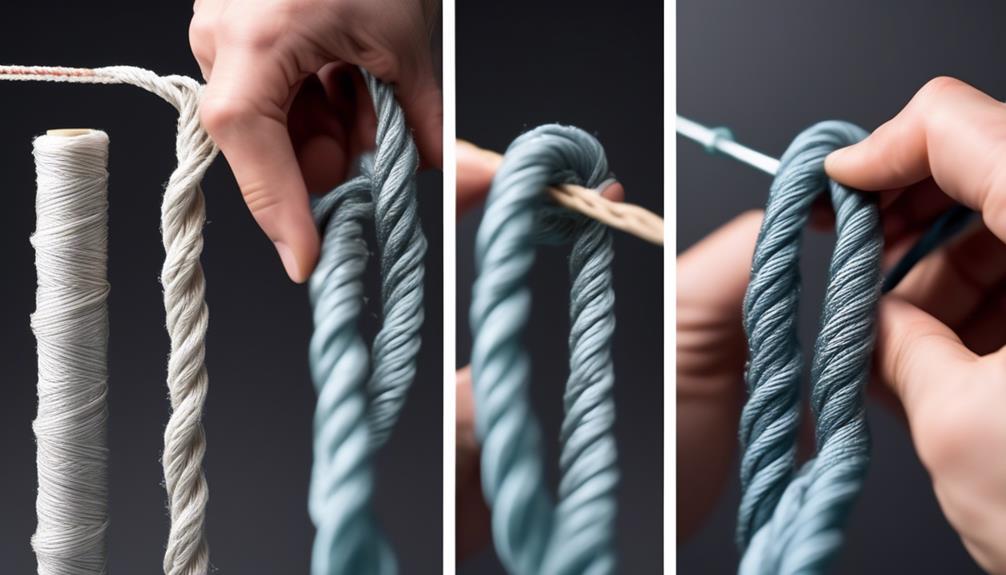
When it comes to ensuring the reliability of your fishing knots, testing their strength is essential for guaranteeing a secure connection between your line and terminal tackle. Here are some techniques for testing knot strength:
- The Pull Test:
After tying your knot, firmly grip the mainline and the terminal tackle, then pull them in opposite directions. Apply steady pressure to see how the knot holds up. If the knot slips or breaks under moderate tension, it may not be suitable for use.
- Using a Scale:
For a more precise measurement, you can use a small handheld scale to test the knot's breaking point. Secure the terminal tackle and the mainline, then attach the scale to one end of the line. Slowly apply pressure to the scale until the knot gives way. This method provides a numerical value for the knot's breaking strength, allowing for better knot performance evaluation.
- Repeated Casting and Retrieval:
Another way to evaluate knot strength is through practical application. Cast your line and retrieve it several times, paying attention to any signs of weakness or slippage in the knot. If the knot holds up through multiple casting and retrieval cycles, it demonstrates its reliability in real fishing conditions.
Enhancing Knot Tying Efficiency
To improve your efficiency in tying fishing knots, streamline your movements and focus on maintaining consistent tension throughout the process. Speedy techniques and knot tying hacks can make a significant difference in how quickly and effectively you can secure your fishing line.
One speedy technique to enhance your knot tying efficiency is to practice the knot several times before actually tying it on your fishing line. This allows you to familiarize yourself with the steps involved, making the process smoother and quicker when you're out on the water. Additionally, using tools like a nail knot tool or a hook tier can help you tie knots more rapidly and with better precision, especially in challenging conditions.
Another knot tying hack is to keep your line and leader materials organized and easily accessible. This can involve using line spools with built-in cutters, pre-cutting leader materials, or utilizing small containers to keep everything tidy and within reach. By reducing the time spent searching for and preparing materials, you can focus on the knot tying process, leading to improved efficiency.
Furthermore, consider using simpler knots that are easier and quicker to tie, especially when you need to re-tie frequently. For example, the improved clinch knot is a reliable and straightforward choice that can be tied efficiently, even in low light or adverse weather conditions.
Frequently Asked Questions
What Are the Best Fishing Knots for Specific Types of Fishing Lines?
When choosing the best fishing knots for specific types of fishing lines, consider knot strength and line compatibility. Different knots work better with different types of fishing line, such as monofilament, fluorocarbon, or braided line.
For example, the Palomar knot is known for its strength and is versatile with various lines.
The improved clinch knot is great for monofilament lines, while the double uni knot is ideal for connecting different line types.
How Do You Prevent Fishing Knots From Slipping or Coming Undone?
To prevent fishing knots from slipping or coming undone, ensure knot security by using the right knot for the type of fishing line you're using.
Apply knot lubrication before tightening to reduce friction and maintain knot strength.
When tightening the knot, do so carefully and gradually to avoid damaging the line.
Taking these precautions will help keep your fishing knots secure and prevent them from slipping or unraveling while you're out on the water.
Are There Any Special Techniques for Tying Fishing Knots in Windy or Wet Conditions?
When tying fishing knots in windy or wet conditions, you can use knot tying tools and adapt your techniques. Secure your line by using tools like clamps or pliers.
Adjust your knot tying technique to accommodate the challenging conditions by keeping the line taut and using quick, precise movements.
Consider using simpler knots that are easier to tie in adverse weather.
These adjustments will help you maintain a strong and secure knot even in difficult conditions.
Can Different Fishing Knots Affect the Presentation of the Bait or Lure?
Different fishing knots can definitely affect the presentation of your bait or lure. The type of knot you use can impact how your bait moves in the water, affecting its natural appearance and enticing fish to strike.
Additionally, the strength and durability of the knot will determine how well it holds up under pressure, ensuring that your catch stays on the line once hooked.
It's essential to choose the right knot for the desired presentation and fishing conditions.
Are There Any Specific Fishing Knots That Are Better for Catching Certain Types of Fish?
When it comes to matching knots with specific fish, there are definitely some options that work better for certain types of fish. For example, the Palomar knot is great for bass fishing, while the Improved Clinch knot is better for trout.
Matching the right knot to the fish you're targeting can make a big difference in your success. It's important to learn and practice different fish-specific knots to improve your chances of catching specific types of fish.
Conclusion
Now that you've learned these 11 handy tips for mastering fishing knots, you can confidently tie strong and reliable knots for your fishing adventures.
Remember to practice and use the right tools to improve your skills, and always test the strength of your knots before heading out.
With these tips in mind, you'll be well-equipped to handle any fishing situation and enjoy a successful day on the water.
Happy fishing!
